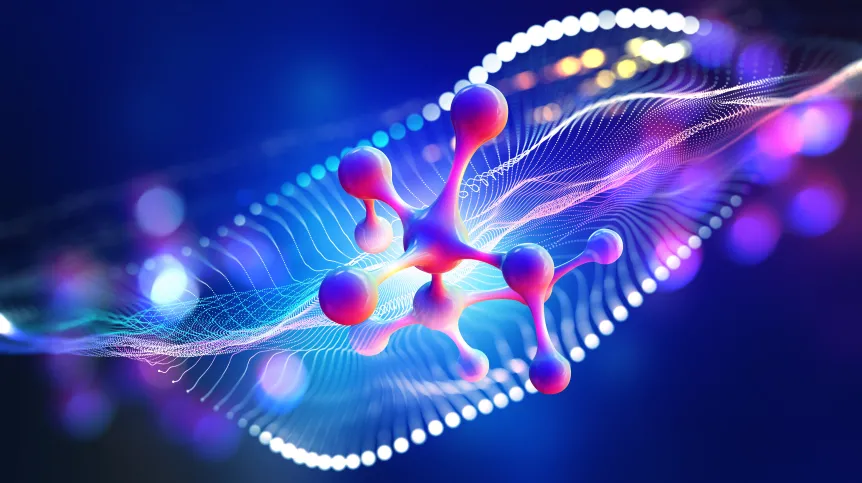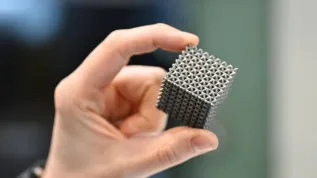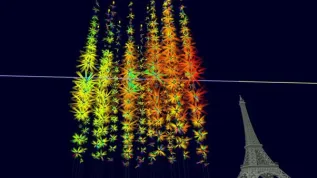
A program that uses artificial intelligence to predict toxicity and properties of metal oxide nanoparticles is being developed by scientists from Gdańsk.
The NanoQsar Toolbox will make it possible to virtually search millions of still unknown materials to find those with the best properties that are also safe for human health and the environment.
In simple terms, nanoparticles are structures with a diameter of 1-100 mm (sizes that are not visible under an optical microscope). They are usually systems of various chemical molecules. They can take extraordinary shapes, including balls, tubes, fibres, cubes, frames, needles...
The properties of nanoparticles are often completely different from the properties of the chemical compounds they consist of. The possibilities of designing nanoparticles are virtually unlimited. That is why nanomaterials (materials made of nanoparticles) are such an attractive research topic.
Professor Tomasz Puzyn from the University of Gdańsk and the company QSARLab (a spin -off founded by employees of the Faculty of Chemistry of the University of Gdańsk) told PAP - Science in Poland that the nanoparticles enjoying the greatest interest of scientists and industry so far include the nanoparticles of metal oxides, especially the titanium, zinc and silicon oxides.
For example, titanium dioxide is a hope in the production of paints, photovoltaic cells, has great catalytic properties, as well as potential in medical applications and cosmetics. The question is, how to 'decorate' this compound on a nano scale to best use its potential.
Now companies that use titanium oxide and hope that the nanoparticles they use can still be improved, will gain a new tool to search for nanoparticles with their dream properties.
Using the available data sets on nanoparticles, a team from QSARLab has prepared an AI-based program called nanoQSAR Toolbox (abbreviated nQTb), which predicts the properties of other nanoparticles, including those that have never been created in any laboratory in the world.
The program is able to predict the properties of a given nanomaterial and check if it will be toxic and harmful to the environment.
This information can be obtained before synthesising the actual compound and help to avoid unnecessary costs and save time, eliminating errors before they are made.
For now, the program predicts the properties of nanoparticles based on titanium dioxide, and in time it will also add zinc and silicon oxides.
Until now, new nanoparticles have been prepared 'empirically'.
Puzyn said: “For example, five new nanoparticles with titanium oxide would be synthesized in a lab and their properties tested, which took months or years. And now, thanks to our application, it is possible to quickly test the properties in your computer and preliminarily check the toxicity of 5 million different nanoparticles.”
One of the solutions found thanks to mathematical models implemented in the program will soon go into production.
Puzyn continued: “Catalysts with titanium oxide nanoparticles are used in AC devices. They help, among other things, to more effectively catch and destroy viruses from the air.
“However, the nanoparticles used so far had to be illuminated with UV light to work better, which was not an optimal solution. Researchers were searching for nanoparticles that would work equally effectively when illuminated with visible light. Thanks to the program from Gdańsk, such nanoparticles have already been found and tested. One of the Polish companies is already involved in their implementation in production.”
Researchers also collaborate with the Chinese Academy of Sciences in the search for nanoparticles that will be used in the transport of drugs to the brain in the treatment of neurodegenerative diseases (e.g. Alzheimer's, Parkinson's).
The scientist points out that predicting the properties of nanoparticles is a much more difficult task than predicting the properties of 'classical' chemical compounds. Nanoparticles can change their structures and shapes depending on the external conditions. For example, in various conditions, nanoparticles can bind into larger agglomerates or degrade into smaller parts. And this leads to changes in their properties.
In example, Puszyn pointed to the mouth, where the pH is higher and a nanoparticle can have completely different properties than the same nanoparticle in the stomach, where the environment is strongly acidic.
This type of information must be taken into account when predicting the toxicity of a given nanoparticle and the possibility of using it in specific applications. This is what Polish scientists are working on.
Researchers from the University of Gdańsk and QSARLab together with scientists from several centres in the world describe the challenges related to the description of the structure of nanoparticles for the needs of predictive computer science in a paoer published in Nature Nanotechnology https://www.nature.com/articles/s41565-022 -01173-6.
For now, human imagination limits people when designing nanoparticles with unusual properties. Programs that use artificial intelligence and machine learning are expected to support human imagination and allow to invent and test previously unknown nanoparticles with unimaginable properties faster. Thanks to Polish scientists, researchers designing new nanomaterials gain support for their imagination.
Work on the application is possible thanks to two grants from the National Research and Development Centre.
PAP - Science in Poland, Ludwika Tomala
lt/ ekr/ kap/
tr. RL













